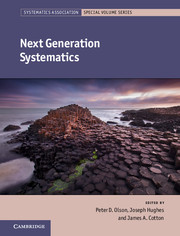Book contents
- Frontmatter
- Contents
- List of contributors
- Introduction: studying diversity in an era of ubiquitous genomics
- Part I Next Generation Phylogenetics
- 1 Perspective: Challenges in assembling the ‘next generation’ Tree of Life
- 2 The role of next generation sequencing technologies in shaping the future of insect molecular systematics
- 3 Phylogenomics of Nematoda
- 4 High-throughput multiplexed mitogenomics for Metazoa: prospects and limitations
- 5 Investigating bacterial microevolution through next generation sequencing
- Part II Next Generation Biodiversity Science
- Part III Next Generation Challenges and Questions
- Index
- Systematics Association Special Volumes
- Plate section
- References
4 - High-throughput multiplexed mitogenomics for Metazoa: prospects and limitations
from Part I - Next Generation Phylogenetics
Published online by Cambridge University Press: 05 June 2016
- Frontmatter
- Contents
- List of contributors
- Introduction: studying diversity in an era of ubiquitous genomics
- Part I Next Generation Phylogenetics
- 1 Perspective: Challenges in assembling the ‘next generation’ Tree of Life
- 2 The role of next generation sequencing technologies in shaping the future of insect molecular systematics
- 3 Phylogenomics of Nematoda
- 4 High-throughput multiplexed mitogenomics for Metazoa: prospects and limitations
- 5 Investigating bacterial microevolution through next generation sequencing
- Part II Next Generation Biodiversity Science
- Part III Next Generation Challenges and Questions
- Index
- Systematics Association Special Volumes
- Plate section
- References
Summary
Introduction
Mitochondrial gene markers have been used in molecular systematics for well over 25 years and they have an established role in resolving phylogenetic and ecological patterns in a multitude of phyla and across a range of taxonomic levels (Randi 2000; Avise 2004). However, there are some problems and limitations in their use; in-depth studies over the last three decades have shown that mitochondrial DNA (mtDNA) is not always inherited clonally through the maternal line, nor is it evolving neutrally (Ballard and Whitlock 2004; Galtier et al. 2009). Also, PCR-based approaches can inadvertently amplify nuclear copies of mitochondrial genes (NUMTs) thus introducing non-homologous signal to datasets (Bensasson et al. 2001). However, for the molecular taxonomist and systematist ‘mtDNA is the most convenient and cheapest solution when a new species has to be genetically explored in the wild’ (Galtier et al. 2009, p. 4541).
Meanwhile, the use of entire mitochondrial genomes (mitogenomes) in systematics has had a varied history since they became available as a tractable source of phylogenetic data. Often met with either enthusiasm or hostility it is clear that their reliability as accurate estimators of species trees has been dependent upon our knowledge of the mitogenomes themselves and how to model the evolutionary signal contained within while accounting for lineage-specific differences in rate heterogeneity and nucleotide composition. Only through denser taxonomic sampling across the Metazoa have mitogenomes become better understood, easier to characterize, and more attractive as a source of homologous markers across multiple levels of organization; from nucleotides to amino acids, from gene content to genetic code and gene order. In order to expand on the known mitogenomes, NGS techniques offer a diversity of methods for fast characterization of novel mitogenomes but, depending on the starting material and the NGS platform, there remain barriers as to which techniques might be most cost-effective and reliable. Here we review recent published studies, report on unpublished work of our own, provide empirical evidence from simulations and cast a critical eye over the prospects and limitations we currently see for reliable use of NGS and high-throughput mitogenome sequencing in the context of systematics and biodiversity studies.
- Type
- Chapter
- Information
- Next Generation Systematics , pp. 84 - 100Publisher: Cambridge University PressPrint publication year: 2016

